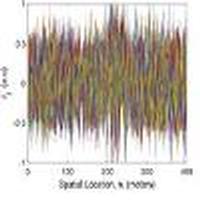当前位置:
X-MOL 学术
›
Opt. Express
›
论文详情
Our official English website, www.x-mol.net, welcomes your feedback! (Note: you will need to create a separate account there.)
Segregating the true perturbation position from ghost energy points region in ϕ-OTDR systems.
Optics Express ( IF 3.8 ) Pub Date : 2020-02-03 , DOI: 10.1364/oe.378365 Muhammad Adeel , Javier Tejedor , Javier Macias-Guarasa , Chao Shang , Chao Lu
Optics Express ( IF 3.8 ) Pub Date : 2020-02-03 , DOI: 10.1364/oe.378365 Muhammad Adeel , Javier Tejedor , Javier Macias-Guarasa , Chao Shang , Chao Lu

|
ϕ-OTDR perturbation detection applications demand optimal precision of the perturbation location. Strategies for improving both signal-to-noise (SNR) and precision of the perturbation location in a laboratory environment may fail when applying to a very long fiber under test (FUT) in real-field environments. With this deployment, meaningful energy points representing the response of a certain perturbation can be located at random locations of the fiber other than the original location of the perturbation. These random locations are referred to as the ghost energy points that confuse the system to mistakenly consider the location of these points as the original perturbation location. We present in this paper a novel space-time scanning (ST-scan) method that segregates the ghost energy point locations from those of the real perturbation so that the original perturbation location estimation is improved.
中文翻译:

在ϕ-OTDR系统中,将真实的扰动位置与虚幻能量点区域分开。
ϕ-OTDR扰动检测应用要求扰动位置的最佳精度。当在实地环境中应用于非常长的被测光纤(FUT)时,在实验室环境中同时提高信噪比(SNR)和扰动位置精度的策略可能会失败。通过这种部署,可以将表示某种扰动响应的有意义的能量点放置在光纤的随机位置,而不是扰动的原始位置。这些随机位置称为重影能量点,它们使系统错误地将这些点的位置视为原始扰动位置。
更新日期:2020-02-03
中文翻译:

在ϕ-OTDR系统中,将真实的扰动位置与虚幻能量点区域分开。
ϕ-OTDR扰动检测应用要求扰动位置的最佳精度。当在实地环境中应用于非常长的被测光纤(FUT)时,在实验室环境中同时提高信噪比(SNR)和扰动位置精度的策略可能会失败。通过这种部署,可以将表示某种扰动响应的有意义的能量点放置在光纤的随机位置,而不是扰动的原始位置。这些随机位置称为重影能量点,它们使系统错误地将这些点的位置视为原始扰动位置。



























 京公网安备 11010802027423号
京公网安备 11010802027423号